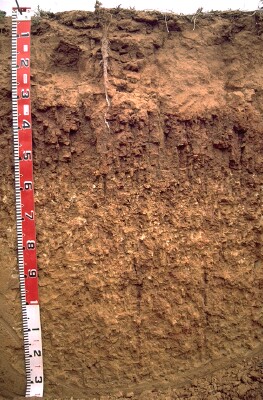LP121
| Group: Bendigo Creek Floodplain Group | Australian Soil Classification: Mottled-Sodic, Hypocalcic, Red CHROMOSOL |
| Northcote Factual Key:Dr 4.23 | Great Soil Group: red-brown earth |
| General Landscape Description: Level Plain. | Geology:. Alluvial deposits (Quaternary). Shepparton formation |
 LP121 Landscape |
Soil Profile Morphology
Surface Soil
| A1 | 0-15 cm | Dark brown (7.5YR3/4), loamy sand; firm consistence when moderately moist; pH 5.7; clear change to: |  LP121 Profile |
| A2 | 15-35 cm | Dark reddish brown (5YR3/4), loamy sand; strong consistence when moderately moist; pH 6.4; abrupt change to: | |
| Subsoil | |||
| B21 | 35-55 cm | Reddish brown (5YR4/4), medium clay; weak coarse prismatic structure, breaking to strong medium sized blocky structure; strong consistence when moderately moist; pH 7.5; clear change to: | |
| B22 | 55-75 cm | Yellowish red (5YR4/6) with strong brown (7.5YR5/6) and yellowish brown (10YR5/6) mottles, light medium clay; weak coarse polyhedral structure, breaking to moderate fine polyhedral structure; strong consistence when moderately moist; few (5%) hard carbonate nodules (up to 50 mm); pH 8.6; gradual change to: | |
| B23 | 75-100 cm | Yellowish brown (10YR5/8) with reddish brown (5YR4/4) mottle, light medium clay; weak coarse polyhedral structure, breaking to moderate fine polyhedral structure; strong consistence when moderately moist; few (3%) hard carbonate nodules(up to 50 mm); pH 8.7; gradual change to: | |
| B24 | 100-130 cm | Strong brown (7.5YR4/6), light medium clay; moderate medium sized prismatic structure, breaking to weak medium sized polyhedral structure; trace of carbonate; pH 8.9. | |
Key Profile Features:
- Strong texture contrast between surface (A) horizon and subsurface (B) horizons
Soil Profile Characteristics:
pH | Salinity Rating | |||
Surface (A1 horizon) | moderately acid | very low | non-sodic | none |
Subsoil (B21 horizon) | slightly alkaline | very low | non-sodic | slight 1 |
Deeper subsoil (at 100-130 cm) | strongly alkaline | low | strongly sodic | moderate 1 |
| 1 Strong dispersion when remoulded. | ||||
 |
Management Considerations:
Surface (A) Horizons
- The surface horizons have a low inherent fertility (based on the sum of the basic exchangeable cations).
- The surface horizons have a low wilting point. This implies that after only a small amount of rainfall there will be moisture available for plant uptake.
- Organic carbon levels show that organic matter content is low for the surface soil from this pit. Organic matter is important for enhancing soil aggregation, fertility and water holding capacity. Organic matter levels will build up under pasture but will decline if cultivation takes place. Practices such as residue retention, minimum tillage and including pasture rotations should be utilised if cropping occurs.
Subsoil (B) Horizons
- Most of the subsoil (all below 55 cm) is sodic and dispersive which will result in restricted root and water movement in the soil. The upper subsoil should be relatively good for water and root penetration (ie. non-sodic and well structured) compared to most other sites.
- The deeper subsoil (from 55 cm depth) is strongly alkaline which indicates that some nutrients (eg. copper, iron, manganese, and zinc) may be poorly available to deeper rooted plants.
Notes
- Profile described by Paul Rampant and Ruth Lourey (23/5/96)


